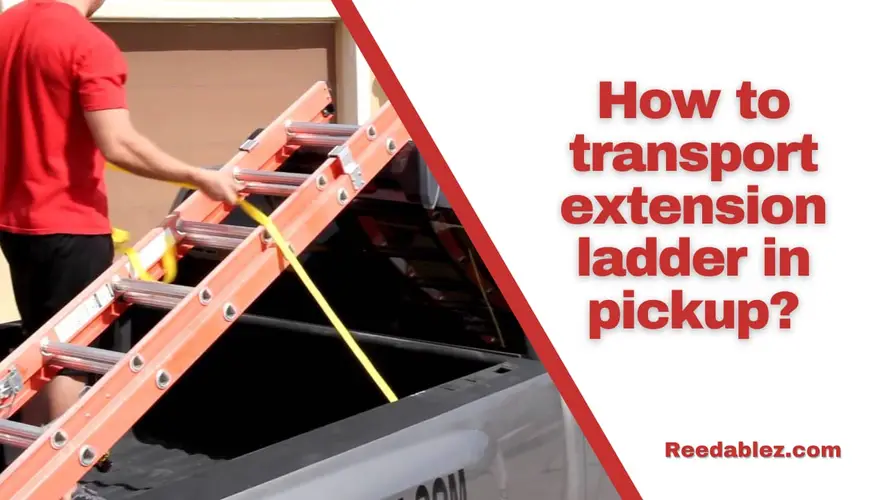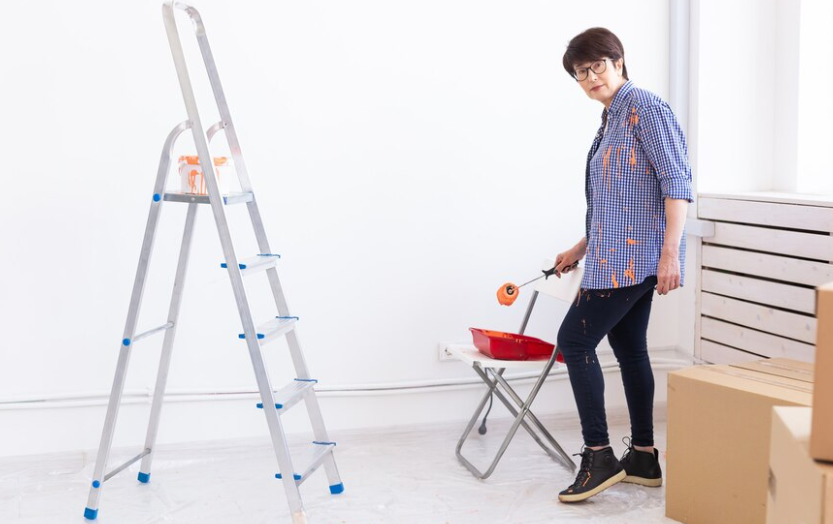Will motherboard turn on without CPU?
April 14, 2018

Transporting an extension ladder in a pickup truck may seem like a straightforward task, but doing it safely and efficiently requires careful planning and execution.
Securely transport an extension ladder in a pickup by using a ladder rack or bed hooks and tie-down straps. Position the ladder diagonally in the bed to distribute weight evenly. Use foam blocks or pool noodles for protection. Flag the ladder for visibility, drive cautiously, and periodically check its stability during the journey.
Whether you're a DIY enthusiast or a professional tradesperson, this comprehensive guide will take you through various methods, equipment, and safety considerations to ensure your extension ladder reaches its destination securely and without causing damage to your truck or other motorists.

Before loading any equipment, familiarize yourself with your pickup truck's specifications, including bed size, payload capacity, and any weight distribution guidelines provided by the manufacturer. Understanding these details is crucial for safe transportation.
Choose an extension ladder that suits the task at hand and can be accommodated by your pickup truck. Consider the ladder's length, weight, and material. Fiberglass ladders are often preferred for their durability and resistance to weather elements.
To prevent damage to your pickup truck and ensure the safety of others on the road, secure the ladder's ends. Use padded materials such as foam blocks or pool noodles to protect both the ladder and the truck's surfaces.
Investing in a quality ladder rack designed for pickup trucks is a wise choice for regular ladder transport. These racks typically mount on the truck's bed, providing a secure platform for the ladder. Choose a rack that matches your ladder's length and your truck's bed size.
If a ladder rack is not an option, use bed hooks and tie-down straps to secure the extension ladder in the bed. Position the ladder diagonally across the bed to distribute weight evenly. Loop the straps through the rungs and secure them to the bed hooks, ensuring a snug fit.
For longer extension ladders that may extend beyond the truck's bed, a bed extender can be a valuable addition. This accessory provides additional support and prevents the ladder from protruding dangerously into traffic.
To prevent the ladder's ends from damaging your truck's rear window, use a protective barrier. Soft materials like blankets or specialized window guards can be secured between the ladder and the window.
When transporting long or protruding loads, attach a bright-colored flag to the ladder's end. This enhances visibility for other motorists, reducing the risk of accidents or collisions.
Ensure that the extension ladder doesn't extend beyond the rear of your truck more than necessary. Overhanging loads can be hazardous to other drivers and pedestrians and may violate traffic regulations.
Before hitting the road, conduct a stability test. Shake the ladder gently to ensure it's securely fastened. Adjust straps or reposition the ladder if needed to prevent shifting during transit.
Adopt a cautious driving approach when transporting an extension ladder. Avoid sudden stops or sharp turns, and maintain a safe following distance. Drive at a moderate speed to reduce wind resistance and enhance stability.
During your journey, periodically check the straps and the ladder's security. Factors like wind, vibrations, and road conditions can impact the stability of the load. Re-tighten straps as necessary to maintain a secure hold.
When reaching your destination, carefully unload the extension ladder. Use a helper if needed, and follow proper lifting techniques to prevent injuries.
When not in use, store your extension ladder in a secure and protected location. Consider using ladder brackets or wall-mounted racks in your garage or workspace.
Transporting a ladder without a roof rack requires careful planning and adherence to safety guidelines. While a roof rack provides a secure platform for ladders, there are alternative methods for those without this accessory. Here's a step-by-step guide on how to transport a ladder without a roof rack:

Select a ladder that is suitable for your task and can be accommodated by your vehicle. Consider the ladder's length, weight, and material. Fiberglass ladders are often preferred for their durability and resistance to weather elements.
If you have a pickup truck, the bed can be an ideal place to transport a ladder. Position the ladder diagonally across the bed to distribute weight evenly. Ensure the ladder is secured and won't shift during transit.
Use high-quality tie-down straps to secure the ladder in the bed of your truck. Loop the straps through the rungs of the ladder and attach them to the bed's anchor points. Tighten the straps to ensure a snug fit.
To prevent scratches and damage, use padded materials such as foam blocks or pool noodles. Place these materials on the contact points between the ladder and the truck bed to provide a protective barrier.
For smaller ladders, consider transporting them inside your vehicle's interior. Lay the ladder on the back seat or across the floor, securing it with seat belts or additional straps. Ensure that the ladder is stable and won't interfere with driving.
If the ladder extends beyond the bed or rear of the vehicle, attach a bright-colored flag to the ladder's end. This enhances visibility for other motorists, reducing the risk of accidents.
If your vehicle has a trailer hitch, you can consider using a hitch-mounted ladder rack. These racks provide a secure attachment point for ladders without requiring a roof rack.
Some vehicles come equipped with rear ladder mounts. These mounts are specifically designed for transporting ladders safely. If your vehicle has this feature, follow the manufacturer's guidelines for secure attachment.
If you drive an SUV or minivan, transporting a ladder inside is a viable option. Fold down the back seats to create a flat surface, and place the ladder inside the vehicle. Secure it with straps or bungee cords.
Check Local Regulations
Be aware of local regulations regarding the transportation of large items. Some areas may have specific rules regarding overhanging loads or the need for flags and markers.
Adopt a cautious driving approach when transporting a ladder. Avoid sudden stops, sharp turns, and maintain a safe following distance. Drive at a moderate speed to reduce wind resistance and enhance stability.
By following these steps and prioritizing safety, you can successfully transport a ladder without a roof rack. Always consider the specific features of your vehicle and the size of the ladder to ensure a secure and hazard-free journey.
Transporting a ladder on a car requires careful consideration of the ladder's size, the vehicle's design, and safety measures. Whether you're a DIY enthusiast or a professional tradesperson, follow these steps for a secure and safe transportation of a ladder on your car:
Before attempting to transport a ladder on your car, measure its length and ensure it is suitable for your vehicle. Consider the size of your car and whether it can accommodate the ladder safely.
If your car is equipped with a roof rack, this is the most secure option for ladder transport. Place the ladder horizontally across the roof rack, ensuring it is centered and balanced. Secure the ladder using straps or bungee cords, and tighten them to prevent movement.
Consider installing specialized ladder racks designed for cars without a built-in roof rack. These racks are designed to attach securely to the roof or rain gutters, providing a stable platform for the ladder.
To prevent scratches or damage to both the ladder and the car, place foam blocks or pool noodles on the roof rack or directly on the car roof. These act as a protective barrier and provide cushioning during transportation.
Place the ladder in a horizontal position, parallel to the car's length. Ensure that both ends of the ladder are securely supported, either by the roof rack or ladder racks, to prevent overhanging or instability.
Use high-quality tie-down straps to secure the ladder to the roof rack or ladder racks. Loop the straps through the ladder's rungs and attach them to the roof rack or designated attachment points on ladder racks. Tighten the straps to create a secure hold.
If the ladder extends beyond the car's length, attach a bright-colored flag to the ladder's end. This enhances visibility for other motorists and reduces the risk of accidents.
Adopt a cautious driving approach when transporting a ladder on your car. Avoid high speeds, sudden stops, and sharp turns. Be aware of the increased height of your vehicle and drive cautiously to prevent accidents.
Be aware of local regulations regarding the transportation of large items on the roof of your car. Some areas may have specific rules regarding overhanging loads or the need for flags and markers.
For smaller ladders or cars without roof racks, consider transporting the ladder inside the car. Ensure that the ladder is securely positioned, does not obstruct your view, and is well-secured with straps or bungee cords.
By following these steps and prioritizing safety, you can transport a ladder on your car effectively. Always consider the size of your ladder, the features of your vehicle, and local regulations to ensure a secure and hazard-free journey.
Transporting an extension ladder in your pickup truck requires careful planning and adherence to safety guidelines. Whether you opt for a dedicated ladder rack or use tie-down straps, prioritizing stability and securing the ladder's ends are key. By following this comprehensive guide, you'll not only protect your pickup truck and ladder but also ensure the safety of yourself and others on the road. Master the art of ladder transportation, and confidently embark on your next project with the right tools securely in tow.
The most secure method is to use a dedicated ladder rack designed for pickup trucks. It provides a stable platform for the ladder and minimizes the risk of damage to your truck or the ladder.
Yes, you can use tie-down straps and bed hooks to secure the ladder in the bed of your pickup. Position the ladder diagonally to distribute weight evenly and ensure a snug fit.
Use padded materials such as foam blocks or pool noodles to protect both the ladder and your truck's surfaces. This prevents scratches and dents during transportation.
Always adhere to your pickup truck's payload capacity as specified in the manufacturer's guidelines. Exceeding this capacity can compromise safety and may damage your vehicle.
Yes, a bed extender is recommended for longer ladders that may extend beyond the truck's bed. It provides additional support and helps prevent the ladder from protruding dangerously into traffic.
Overhanging loads can be hazardous and may violate traffic regulations. Adjust the ladder's position or consider using a longer bed extender to ensure it doesn't extend beyond the truck more than necessary.
Drive cautiously, avoiding sudden stops or sharp turns. Maintain a safe following distance, and drive at a moderate speed to reduce wind resistance. Periodically check the ladder's stability during your journey.
Comments
Write a comment